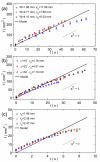Imbibition of Newtonian Fluids in Paper-like Materials with the Infinitesimal Control Volume Method
- PMID: 34832802
- PMCID: PMC8626007
- DOI: 10.3390/mi12111391
Imbibition of Newtonian Fluids in Paper-like Materials with the Infinitesimal Control Volume Method
Abstract
Paper-based microfluidic devices are widely used in point-of-care testing applications. Imbibition study of paper porous media is important for fluid controlling, and then significant to the applications of paper-based microfluidic devices. Here we propose an analytical approach based on the infinitesimal control volume method to study the imbibition of Newtonian fluids in commonly used paper-like materials. Three common paper shapes (rectangular paper strips, fan-shaped and circular paper sheets) are investigated with three modeling methods (corresponding to equivalent tiny pores with circle, square and regular triangle cross section respectively). A model is derived for liquid imbibition in rectangular paper strips, and the control equations for liquid imbibition in fan-shaped and circular paper sheets are also derived. The model is verified by imbibition experiments done using the mixed cellulose ester filter paper and pure water. The relation of imbibition distance and time is similar to that of the Lucas-Washburn (L-W) model. In addition, a new porosity measurement method based on the imbibition in circular paper sheets is proposed and verified. Finally, the flow rates are investigated. This study can provide guidance for the design of different shapes of paper, and for better applications of paper-based microfluidic devices.
Keywords: imbibition; infinitesimal control volume method; microfluidics; paper-based microfluidic devices; paper-like material.
Conflict of interest statement
The authors declare no conflict of interest.
Figures








Similar articles
-
Effects of Relative Humidity and Paper Geometry on the Imbibition Dynamics and Reactions in Lateral Flow Assays.Langmuir. 2022 Aug 16;38(32):9863-9873. doi: 10.1021/acs.langmuir.2c01017. Epub 2022 Aug 1. Langmuir. 2022. PMID: 35913402
-
Capillary imbibition and flow of wetting liquid in irregular capillaries: A 100-year review.Adv Colloid Interface Sci. 2022 Jun;304:102654. doi: 10.1016/j.cis.2022.102654. Epub 2022 Mar 29. Adv Colloid Interface Sci. 2022. PMID: 35468356 Review.
-
Imbibition in porous membranes of complex shape: quasi-stationary flow in thin rectangular segments.Langmuir. 2010 Jan 19;26(2):1380-5. doi: 10.1021/la902470b. Langmuir. 2010. PMID: 19845342
-
Spontaneous Imbibition in Paper-Based Microfluidic Devices: Experiments and Numerical Simulations.Langmuir. 2022 Mar 1;38(8):2677-2685. doi: 10.1021/acs.langmuir.1c03403. Epub 2022 Feb 15. Langmuir. 2022. PMID: 35168321
-
Recent developments in flow modeling and fluid control for paper-based microfluidic biosensors.Biosens Bioelectron. 2021 Apr 15;178:113026. doi: 10.1016/j.bios.2021.113026. Epub 2021 Jan 23. Biosens Bioelectron. 2021. PMID: 33545552 Review.
Cited by
-
A Parametric Study on a Paper-Based Bi-Material Cantilever Valve.Micromachines (Basel). 2022 Sep 9;13(9):1502. doi: 10.3390/mi13091502. Micromachines (Basel). 2022. PMID: 36144125 Free PMC article.
References
Grants and funding
LinkOut - more resources
Full Text Sources

